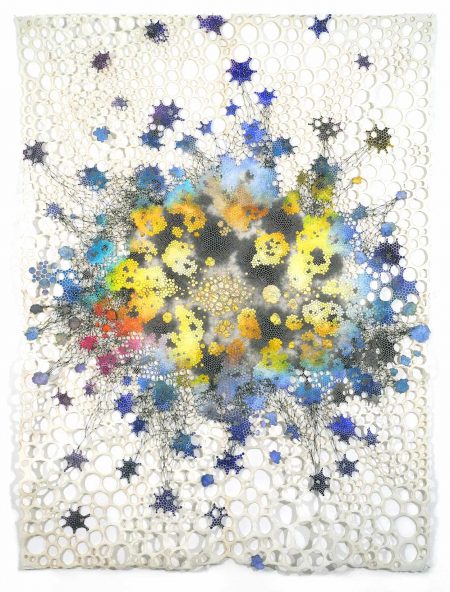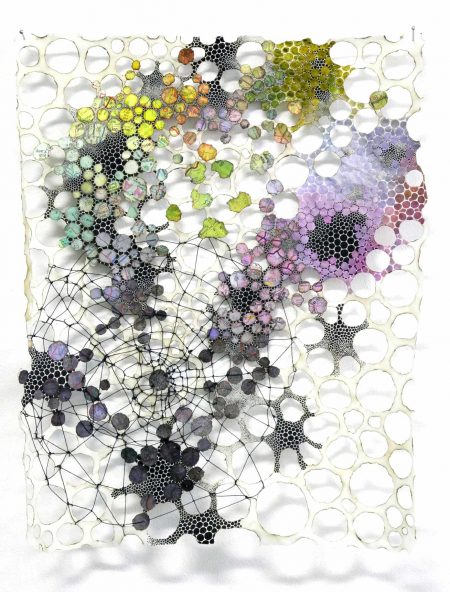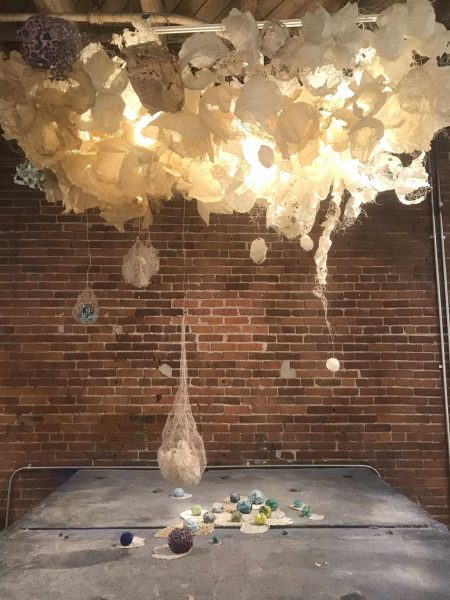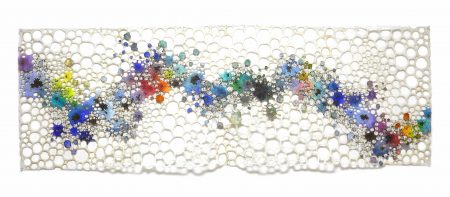Having pervaded Western societies for centuries, the archetype of huge and showy artworks seems to have reached a pinnacle in our era where large and loud look better online. Karen Margolis’ delicate, meditative collages, on view through May 12 at Garis & Hahn in Los Angeles, pull the proverbial rug out from under the preconceived notion that artworks should dazzle at first sight. From across the room and in online images, Margolis’ tapestry-like collages might appear unassumingly crafty, possibly even kitschy. Incorporating traditional handicrafts such as sewing and paper-cutting, her daintily porous works appear lacelike, their shapes resembling quasi-utile mats or table-runners. This deceptively decorative appearance only enhances your sense of surprise when you approach one of the collages and find yourself captivated like a fly in a spider’s lair, completely engrossed by manifold orbs and sewn thread webs of mesmeric abstract detail.
The show’s title, “Garden of Mutei,” refers to a “starting point of emptiness from which form can emerge.” Mutei is a Japanese Zen term that translates to a sense of nothingness. Perhaps Margolis was inspired by Ryōan-ji temple in Kyoto, Japan, which contains a Zen garden of raked rocks associated with mutei.
Margolis’ morphologies loosely parallel forms seen in Zen rock gardens. Circular shapes dominate her compositions. Each tapestry is permeated with carefully burned round holes as in Swiss cheese. One senses the holes being repetitively incinerated into the paper as a meditative gesture. Crisscrossed rainbow threads interlace the interstices, while small ink dots agglomerate into large round masses of variegated color that seem to fluidly pool and explode on the paper between perforations.

Each piece exudes occult magnetism. When perusing Margolis’ richly embellished tapestries, one begins to feel as though in a strange dream or meditative trance. Varied details hold one’s attention in mysterious ways. Repeated motifs such as circular bits ablated from maps seem part of some sort of code. One feels as though trying to interpret Margolis’ abstract iconography as though it were a text of some unintelligible language. In fact, the artist describes her works as color-coded charts of emotion. This show includes a chart on a wall indicating hues that she assigns to various emotions including panic, angst, despair, and fear. This tiny divulgence of knowledge regarding Margolis’ color choices only increases the mysteriousness of her every other formal decision.
Arrangements of miniscule map ablations appear as an idiosyncratically re-constituted personal cartography. Do they represent places the artist has visited, locations that hold important memories, or places she would like to go? It’s impossible to determine for certain, and uncertainty is part of these works’ charm. For one cannot know, one can only feel their strong evocations.
Though predominantly nonobjective, Margolis’ pieces offer lucid glimpses into reality. Splotches of vibrant color resemble bacteria growing in petri dishes, dye dispersing into glasses of water, or delirious visions of tropical bromeliads. Chthonic (2016) contains an unmistakable depiction of a spiderweb.

Composed of paper and wire, the lone sculptural installation in this show evokes a storm cloud looming over a set of globelike balls that could represent spheres of different thought. Given their titles, pieces such as United States (2018) vaguely bring to mind political patchworks. Circular map snippets evoke separate islands connected by tenuous threads.


In our increasingly polarized, troubled times, it often seems as though there is no exit, no breather, only problems. For its meditative ambiguity, Margolis’ Zen-inspired work encourages us to look inward rather than outward, to process private thoughts rather than constantly remaining tuned into digitally fueled morasses of grievances. Yet her works are not escapist: quietly smoldering violence belies Margolis’ burned lacunae; her attempts to stitch together wounded paper seem to embody piercing senses of futility. Deceptively bright colors codify negative emotions, evoking positive facades donned in the faces of difficulty. Margolis’ collaged tapestries allude to timeless pains while offering redemption in the form of reflection.